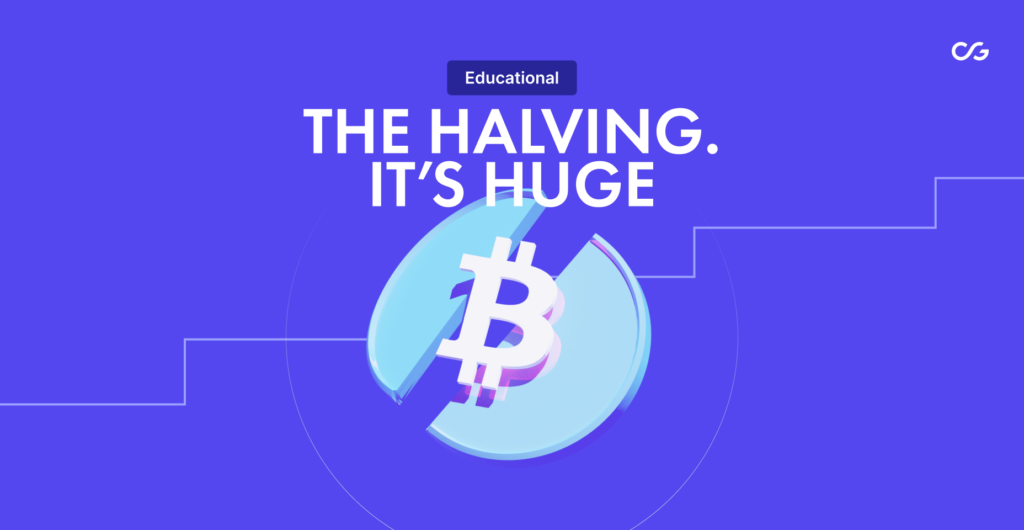
Why the Next Bitcoin Halving Will Be a Monumental Event
Mark your calendars, the much-anticipated fourth Bitcoin halving is set to take place in approximately a year’s time, in April or May 2024.

For those who may not fully grasp the significance of this event or are skeptical of its relevance, this is a golden opportunity to delve deeper into the potential implications and understand why the Bitcoin halving should hold a prominent place on your radar.
To be worth your time, we will also highlight the significance of the Bitcoin halving event by drawing connections with certain key trends and developments happening right now, also addressing concerns that some might have.
By the way, four years ago we also wrote an article about what is now the previous halving event, predicting and assuming how things will change after it happens. Did we get anything right?
This time, we are delving even deeper.
Understanding the Bitcoin Halving
Halving Definition
Every 210,000 blocks – roughly every four years – the rewards that miners receive for adding new blocks to the Bitcoin blockchain are slashed in half. This time, block rewards are getting cut from 6.25 BTC to 3.125 BTC.
This controlled reduction in mining rewards is known as Bitcoin halving. This mechanism was embedded in Bitcoin’s code by its mysterious creator, Satoshi Nakamoto, to enforce rules on the supply and subsequently, tame the inflation of the cryptocurrency.
Why Does Bitcoin Halving Happen?
The primary purpose behind the Bitcoin halving is to control Bitcoin’s supply, making it a deflationary asset. This can be somewhat likened to precious metals, where limited supply can drive value.
However, Bitcoin could easily be considered the scarcest commodity there ever was due to its limited supply and vast dispersion. Note that 92.4% of it is already mined, while the remaining supply of roughly 1,587,000 BTC will be mined over the next century until year 2140.
The next Bitcoin Halving will be the fourth instance of this mechanism being triggered.
Why Pay Attention to the Next Bitcoin Halving? 7 Reasons
The fourth Bitcoin halving is not just a technical event. It’s a pivotal moment that’s interwoven with global economic trends, institutional interest, regulatory advancements, and a paradigm shift in how nations view monetary policy.
The implications of this halving could be far-reaching. Here are seven factors that signify the next bitcoin halving event tremendously.
1. Bitcoin Network’s Robustness
In 2023, the Bitcoin network exhibited unassailable strength with its total hashrate hitting all-time highs multiple times.
Hashrate is a measure of the computational power dedicated to securing the Bitcoin network. An all-time high indicates an increase in mining activity, and thus, network security.
This robustness is vital in maintaining confidence in the network, especially post-halving, when mining rewards are reduced by 50%.
Knowing how tough the last few years have been for Bitcoin and crypto markets, it’s fascinating to see a growing conviction in the network despite failing exchanges, scrutiny from regulators, depegging stablecoins, interest rate hikes and other recent Black Swan-ish events.
The spike in hashrate demonstrates that miners are investing heavily in hardware, signaling their belief in Bitcoin’s long-term value.
2. Institutional Interest: BlackRock, Fidelity, ARK Invest, and More
The impending halving undoubtedly has been under the watchful eyes of financial behemoths.
BlackRock, the world’s largest asset manager with $7 trillion under management, is pushing the SEC to approve its Bitcoin spot ETF.
This would allow institutional investors to invest in Bitcoin directly, which is a testament to the cryptocurrency’s maturing status.
Fidelity, another heavyweight with $4.5 trillion in assets, is doing the same. New York-based asset manager WisdomTree is also pushing in this direction, as are many others that filled Bitcoin ETF applications soon after Blackrock.
These institutions are not known for speculative investments; their interest is a strong indicator of Bitcoin’s long-term potential and should assuage concerns over its legitimacy as an asset class.
3. Regulatory Clarity and Adoption: Hong Kong, the European Union Leading the Way
Another harbinger of Bitcoin’s prominence is the embrace by governments and regulatory bodies.
Hong Kong’s HSBC approved Bitcoin and Ether ETFs, further deepening its ties with cryptocurrency markets and opening doors to investors.
Meanwhile, the European Union introduced MiCA, a regulation that clarifies many of the rules surrounding the crypto industry.
Other places such as the United Arab Emirates (UAE) use crypto for trade, Singapore introducing standards for crypto bank accounts, while Saudi Arabia rush to partner with blockchain firms and crypto projects such as the Sandbox, ready to embrace whatever comes next.
In the meantime, Russia is venturing into bitcoin mining and has already become the second largest bitcoin miner.
The bottom line is, this clarity is instrumental in alleviating the feelings of fear or anxiety of investors and institutions.
It also prepares the ground for broader adoption and innovation, which is likely to escalate following the halving.
4. More Companies Actively Accept Bitcoin Payments
Companies increasingly more often choose to accept Bitcoin and other cryptocurrencies for payments as an alternative option for their customers. This is evident in our yearly payments report suggesting that payments volume increased by 63% in 2022.
If more people are using Bitcoin to trade goods and services, this can create an increased demand for Bitcoin. Given that the halving reduces the supply of new Bitcoin, this can potentially drive up the price if demand outpaces supply.
As more people trade goods and services in Bitcoin, the Bitcoin economy becomes more liquid. This increased liquidity can help to absorb the reduction in new supply brought about by halving, which may stabilize the price to some extent.
Learn more about the benefits of accepting cryptocurrency payments.
5. Bitcoin for Economic Strategy: The Case of El Salvador
In a world first, El Salvador officially adopted Bitcoin as legal tender on September 7, 2021.
President Nayib Bukele argued that embracing Bitcoin could help many Salvadorans transition into the formal economy and make it cheaper and faster for them to receive remittances from abroad.
Despite the widespread skepticism, El Salvador’s Bitcoin experiment seems to be bearing fruit. The country has been buying one Bitcoin each day since November 18, 2022.
El Salvador’s audacious move to make Bitcoin a legal tender demonstrates its utility and potential to foster economic growth. This has caught the attention of various countries, with some exploring the possibility of adopting similar strategies.
But El Salvador went one step further. Back in 2021, the Legislative Assembly of El Salvador has approved a law that paves the way for the issuance of digital assets other than Bitcoin, including a Bitcoin-backed bond known as the ‘Volcano Bond‘.
The funds raised from the Volcano Bonds will be used for various initiatives, including the establishment of a Bitcoin mining industry that solely relies on renewable energy, some of which will be generated by the country’s active volcanoes.
Seeing El Salvador’s success while other countries’ currencies inflate away and lose value, the halving event may spur other countries to hasten their efforts in embracing Bitcoin as part of their economic strategy.
6. Bitcoin’s Scarce Nature: HODLing Through the Storm
The remarkable fact that over 50% of Bitcoin hasn’t moved in two years, despite its price roller-coaster, is a testament to the conviction of its holders. They seemingly believe in its long-term prospects.
Besides, for the first time, Bitcoin now has 1,000,000 wallets with a balance of 1 BTC or more since May 2023, meaning that Bitcoin is likely being held by more hands than ever.
This scarcity effect, which will be amplified by the halving, as it reduces the supply of new coins, may play a significant role in establishing Bitcoin as an ultimate store of value in the world of inflating, depreciating currencies.
7. BTC-20, Ordinals, ‘Right to Mine’ Bills, and All the Rest
Have you seen the US presidential candidate Robert F. Kennedy Jr advocating for Bitcoin rights (and two others, in fact)?
Have you heard about Dennis Porter orange-pilling the US Congress?
Did you know that Texas relies on Bitcoin miners to stabilize the grid?
Did you already lose count how many US states passed the ‘Right to Mine’ Bitcoin bill?
And yet, all that’s been said about Bitcoin by this point is just the tip of the iceberg of what’s happening in the US alone.
The emergence of BRC-20 tokens and Bitcoin Ordinals alone span a new use case and wave of attention to the 15-year old technology. In turn, it caused a fee spike on the network, earning miners $40M a day at one point.
There are many other factors that turn out to be great for Bitcoin miners, making many consider and reconsider how the next halving will impact the industry and asset value.
Addressing Common Concerns About the Bitcoin Halving
Some may be skeptical about the significance of the Bitcoin halving. The major concerns people formed over the past halvings include market volatility, miner exodus, and sustainability. Let’s briefly address them.
Market Volatility Post-Halving
Many fear that the BTC Halving will cause extreme market volatility. Bitcoin’s history does reveal instances of short-term price fluctuations post-halving. Will this time be any different?
With institutional investors asking for Bitcoin spot ETFs and entire countries starting to take notice of Bitcoin while the supply of Bitcoin on exchanges is draining, it’s essential to understand that volatility could also mean opportunity.
At least historically, each halving has led to significant price increases over the medium to long term.
Miner Exodus and Network Security
Some like to point out a potential exodus of miners post-halving due to lower block rewards, which could impact network security. But that’s more of a myth.
If any miners actually leave, this often results in a self-correcting mechanism where mining difficulty adjusts itself every two weeks, allowing efficient miners to remain profitable.
This rebalancing act has been in action since Bitcoin’s birth and has not compromised the network’s integrity in any way.
Long-Term Sustainability
Concerns about Bitcoin’s energy consumption are as loud as ever but tend to overshadow the ongoing efforts in the mining community towards sustainability.
Many mining operations are increasingly turning to renewable sources of energy.
Also, compared to traditional banking and gold mining, the energy consumption of the Bitcoin network might not be as impractical as it is sometimes portrayed.
How Does Bitcoin Halving Event Impact You?
By analyzing the hashrate trends, institutional interest, regulatory clarity, national adoptions, and the immovable nature of Bitcoin holdings, it becomes evident that dismissing the halving as inconsequential would be short-sighted.
The potential for transformative change is palpable, and as astute observers of the financial ecosystem, it is incumbent upon us to pay attention and grasp the magnitude of the opportunities that the halving could unveil.
For people like you and me, the next Bitcoin halving might be an opportunity of a lifetime, or a scary, turbulent and chaotic period.
Ultimately, it all depends on knowledge that you gather along the way, and how it impacts decisions that you make moving on.
With that said, make the most out of the next Bitcoin halving by learning more about Bitcoin and helping others to discover its potential.
One way to get more into Bitcoin and benefit yourself is to start accepting Bitcoin payments in your business.
Check out how CoinGate can help you get more customers and save money on payment fees by accepting crypto payments.
Accept crypto with CoinGate
Accept crypto with confidence using everything you need in one platform.

